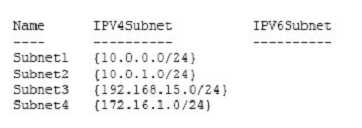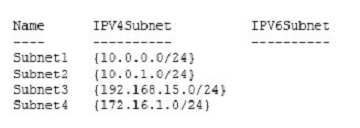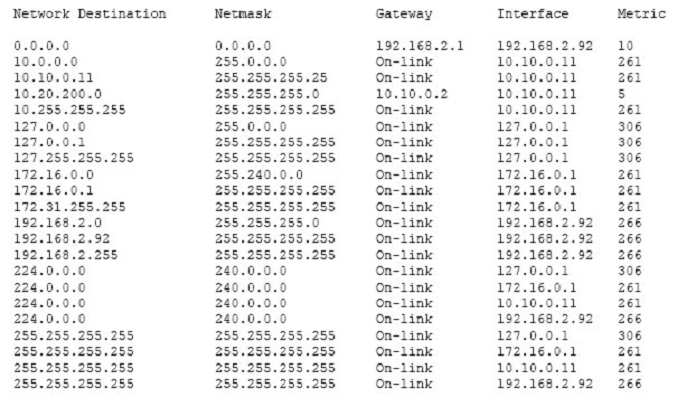Download Networking with Windows Server 2016.70-741.CertDumps.2019-10-13.141q.vcex
| Vendor: | Microsoft |
| Exam Code: | 70-741 |
| Exam Name: | Networking with Windows Server 2016 |
| Date: | Oct 13, 2019 |
| File Size: | 5 MB |
How to open VCEX files?
Files with VCEX extension can be opened by ProfExam Simulator.
Discount: 20%
Demo Questions
Question 1
Note: This question is part of a series of questions that present the same scenario. Each question in the series contains a unique solution that might meet the stated goals. Some question sets might have more than one correct solution, while others might not have a correct solution.
After you answer a question in this sections, you will NOT be able to return to it. As a result, these questions will not appear in the review screen.
Your network contains an Active Directory domain named contoso.com. The domain contains a member server named Server1 that runs Windows Server 2016 and has the DNS Server role installed. Automatic scavenging of stale records is enabled and the scavenging period is set to 10 days.
All client computers dynamically register their names in the contoso.com DNS zone on Server1.
You discover that the names of multiple client computers that were removed from the network several weeks ago can still be resolved.
You need to configure Server1 to automatically remove the records of the client computers that have been offline for more than 10 days.
Solution: You run the dnscmd.exe command and specify the /AgeAllRecords parameter for the zone.
Does this meet the goal?
- Yes
- No
Correct answer: B
Explanation:
https://technet.microsoft.com/en-us/library/cc772069(v=ws.11).aspx https://technet.microsoft.com/en-us/library/cc772069(v=ws.11).aspx
Question 2
Note: This question is part of a series of questions that present the same scenario. Each question in the series contains a unique solution that might meet the stated goals. Some question sets might have more than one correct solution, while others might not have a correct solution.
After you answer a question in this sections, you will NOT be able to return to it. As a result, these questions will not appear in the review screen.
Your network contains an Active Directory domain named contoso.com. The domain contains a member server named Server1 that runs Windows Server 2016 and has the DNS Server role installed. Automatic scavenging of stale records is enabled and the scavenging period is set to 10 days.
All client computers dynamically register their names in the contoso.com DNS zone on Server1.
You discover that the names of multiple client computers that were removed from the network several weeks ago can still be resolved.
You need to configure Server1 to automatically remove the records of the client computers that have been offline for more than 10 days.
Solution: You set the Time to live (TTL) value of all of the records in the zone.
Does this meet the goal?
- Yes
- No
Correct answer: B
Explanation:
https://technet.microsoft.com/en-us/library/cc958972.aspx https://technet.microsoft.com/en-us/library/cc958972.aspx
Question 3
Note: This question is part of a series of questions that present the same scenario. Each question in the series contains a unique solution that might meet the stated goals. Some question sets might have more than one correct solution, while others might not have a correct solution.
After you answer a question in this sections, you will NOT be able to return to it. As a result, these questions will not appear in the review screen.
Your network contains an Active Directory domain named contoso.com. The domain contains a member server named Server1 that runs Windows Server 2016 and has the DNS Server role installed. Automatic scavenging of stale records is enabled and the scavenging period is set to 10 days.
All client computers dynamically register their names in the contoso.com DNS zone on Server1.
You discover that the names of multiple client computers that were removed from the network several weeks ago can still be resolved.
You need to configure Server1 to automatically remove the records of the client computers that have been offline for more than 10 days.
Solution: You modify the Zone Aging/Scavenging properties of the zone.
Does this meet the goal?
- Yes
- No
Correct answer: A
Explanation:
https://technet.microsoft.com/en-us/library/cc771362(v=ws.10).aspx https://technet.microsoft.com/en-us/library/cc771362(v=ws.10).aspx
Question 4
Note: This question is part of a series of questions that present the same scenario. Each question in the series contains a unique solution. Determine whether the solution meets the stated goals.
Your network contains an Active Directory domain named contoso.com. The domain contains a DNS server named Server1. All client computers run Windows 10.
On Server1, you have the following zone configuration.

You have the following subnets defined on Server1.

You need to prevent Server1 from resolving queries from DNS clients located on Subnet4. Server1 must resolve queries from all other DNS clients.
Solution: From Windows Firewall with Advanced Security on Server1, you create an inbound rule.
Does this meet the goal?
- Yes
- No
Correct answer: A
Explanation:
References: https://technet.microsoft.com/en-us/library/dd421709(v=ws.10).aspx References: https://technet.microsoft.com/en-us/library/dd421709(v=ws.10).aspx
Question 5
Note: This question is part of a series of questions that present the same scenario. Each question in the series contains a unique solution. Determine whether the solution meets the stated goals.
Your network contains an Active Directory domain named contoso.com. The domain contains a DNS server named Server1. All client computers run Windows 10.
On Server1, you have the following zone configuration.

You have the following subnets defined on Server1.

You need to prevent Server1 from resolving queries from DNS clients located on Subnet4. Server1 must resolve queries from all other DNS clients.
Solution: From Windows PowerShell on Server1, you run the Add-DnsServerQueryResolutionPolicy cmdlet.
Does this meet the goal?
- Yes
- No
Correct answer: A
Explanation:
References: https://docs.microsoft.com/en-us/powershell/module/dnsserver/add-dnsserverqueryresolutionpolicy?view=win10-ps References: https://docs.microsoft.com/en-us/powershell/module/dnsserver/add-dnsserverqueryresolutionpolicy?view=win10-ps
Question 6
Your company has a main office in London and a branch office in Seattle. The offices connect to each other by using a WAN link.
In the London office, you have a Distributed File System (DFS) server named FS1 that contains a folder named Folder1.
In the Seattle office, you have a DFS server named FS2.
All servers run Windows Server 2016.
You configure replication of Folder1 to FS2.
Users in both offices frequently add files in Folder1.
You monitor DFS Replication, and you discover excessive replication over the WAN link during business hours.
You need to reduce the amount of bandwidth used for replication during business hours. The solution must ensure that the users can continue to save content to Folder1.
What should you do?
- Modify the quota settings on Folder1 on FS2.
- Modify the properties of the replication group.
- Configure the copy of Folder1 on FS2 as read-only.
- Modify the replicated folder properties of Folder1 on FS1.
Correct answer: B
Question 7
Your company owns the public Internet IP address range of 131.107.20.0 to 131.107.20.255.
You need to create a subnet that supports four hosts. The solution must minimize the number of addresses available to the subnet.
Which subnet should you use?
- 131.107.20.16/28
- 131.107.20.16/30
- 131.107.20.0/29
- 131.107.20.0 with subnet mask 255.255.255.224
- 131.107.20.16 with subnet mask 255.255.255.252
Correct answer: C
Explanation:
References: http://jodies.de/ipcalc?host=131.107.20.0&mask1=29&mask2= References: http://jodies.de/ipcalc?host=131.107.20.0&mask1=29&mask2=
Question 8
You have a server named Server1 that runs Windows Server 2016. Server1 has the following routing table.

What will occur when Server1 attempts to connect to a host that has an IP address of 172.20.10.50?
- Server1 will attempt to connect directly to 172.20.10.50.
- Server1 will route the connection to 10.10.0.2.
- Server1 will silently drop the connection attempt.
- Server1 will route the connection to 192.168.2.1.
Correct answer: D
Explanation:
http://www.techrepublic.com/article/understanding-routing-tables/ http://www.techrepublic.com/article/understanding-routing-tables/
Question 9
Your company has two main offices. The offices are located in London and Seattle. All servers run Windows Server 2016.
In the Seattle office, you have a Distributed File System (DFS) server named FS1. FS1 has a folder named Folder1 that contains large Windows image files.
In the London office, you deploy a DFS server named FS2, and you then replicate Folder1 to FS2.
After several days, you discover that the replication of certain files failed to complete.
You need to ensure that all of the files in Folder1 can replicate to FS2.
What should you do?
- Modify the disk quota of the drive that contains Folder1.
- From a command prompt, run dfsutil /purgemupcache.
- Create a quota for Folder1 by using File Server Resource Manager (FSRM).
- Modify the size of the staging area of Folder1.
Correct answer: D
Explanation:
Question 10
You have a server named Server1 that runs Windows Server 2016 and is configured as a domain controller.
You install the DNS Server server role on Server1.
You plan to store a DNS zone in a custom Active Directory partition.
You need to create a new Active Directory partition for the zone.
What should you use?
- Set-DnsServer
- Active Directory Sites and Services
- Dns.exe
- Dnscmd.exe
- New-ADObject
- Active Directory Administrative Center
- DNS Manager
Correct answer: D
Explanation:
dnscmd <ServerName> /CreateDirectoryPartition <FQDN> References:https://docs.microsoft.com/en-us/windows-server/administration/windows-commands/dnscmd#BKMK_5 dnscmd <ServerName> /CreateDirectoryPartition <FQDN>
References:
https://docs.microsoft.com/en-us/windows-server/administration/windows-commands/dnscmd#BKMK_5
HOW TO OPEN VCE FILES
Use VCE Exam Simulator to open VCE files

HOW TO OPEN VCEX AND EXAM FILES
Use ProfExam Simulator to open VCEX and EXAM files


ProfExam at a 20% markdown
You have the opportunity to purchase ProfExam at a 20% reduced price
Get Now!



